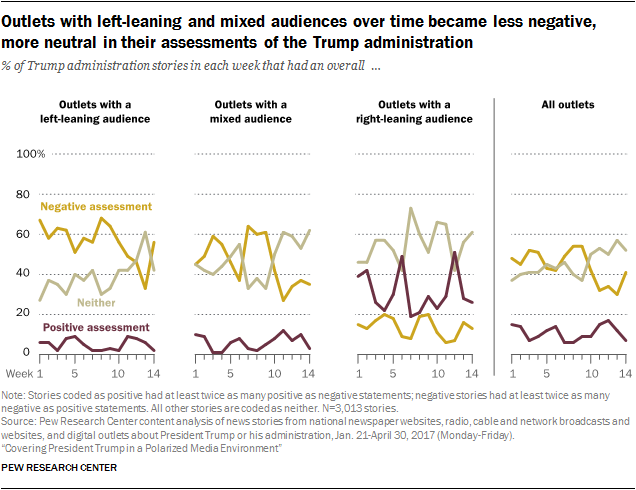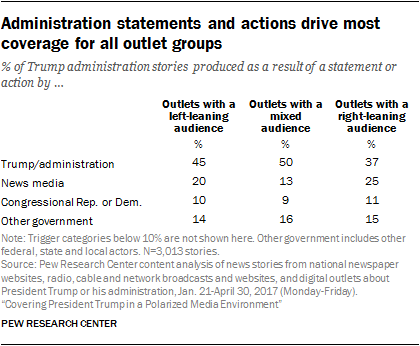Americans’ news habits are diversifying, and where people turn for their political news often differs by their own political leanings. This study examines coverage of the Trump administration’s first 100 days and what impact differences in media choices can have on the news Americans may receive.
The 24 news outlets studied here were organized into three groups based on their audiences’ political orientation: outlets with two-thirds more audience members who are right of center than left (according to Pew Research Center surveys), those with two-thirds more left of center than right, and outlets with a more evenly distributed audience base. In these surveys, respondents were asked whether they regularly got news about the 2016 election or about politics from each outlet.
Overall, the study found that Americans tended to hear about a similar mix of topics from the news media, whether or not those outlets had a left-leaning audience or a right-leaning audience. Similarly, a good deal of the coverage across outlets was framed around the president’s leadership and character rather than policy.
But there were also differences across outlets based on the ideological composition of their audiences. In particular, the balance of positive or negative assessments made about the administration’s words or actions varied, as did the voices that were featured in stories. It was primarily the outlets with a right-leaning audience that differed from those with a left-leaning and a more mixed audience, which were more similar to each other.
It is important to note that there are differences in the coverage across the three platforms studied. For example, stories appearing on a digital platform were overall much more likely to name multiple source types than stories from both television and radio. Even so, there are large differences within platforms across the outlet groupings. For number of source types, three-quarters of digital stories from outlets with a left-leaning audience cited multiple sources, 17 percentage points higher than those from outlets with a right-leaning audience (58%). The same pattern holds for both television and radio. This suggests, then, that platform may be a small part of the story, but is not the full story. There are still decisions made within news organizations that impact the content audiences receive.
General topics covered and overarching frames were similar across outlet groups

During the first 100 days of the Trump administration, news outlets covered a very similar mix of topics and were united in framing their stories much more around leadership rather than policy debates. This was true across the three key groupings of news outlets based on the ideological leaning of their audience.
Outlets with a more left-leaning audience, those that lean more to the right and those with a more mixed audience were about as likely to focus the bulk of their coverage on the same five specific topics: the president’s political skills, immigration, appointments and nominations, U.S.-Russia relations and health care. And rolling up all 44 of the topics studied into three broad areas shows similar proportions of coverage around each: domestic issues, president’s management and political approach, and foreign affairs (though outlets with a more mixed audience put slightly greater emphasis on foreign affairs).
Stories from outlets appealing to a right-leaning audience cite fewer source types – including fewer experts, issue groups and the administration

Beyond the similar topic and frame of stories, however, other differences emerge. A majority of stories from outlets with a left-leaning and a more mixed audience included at least two of nine different types of sources assessed (70% and 62%, respectively). That was true, however, of less than half (44%) of stories from outlets appealing to a right-leaning audience.

The specific types of sources cited less frequently by outlets with a right-leaning audience were members of the Trump administration, outside experts and interest or issue groups.
Outlets with a right-leaning audience were roughly one-fourth as likely as outlets with a left-leaning audience to cite at least one outside expert in their stories (5% compared with 22%) and about one-third as likely to do so as outlets with a more mixed audience (16%).
Similarly, statements from issue groups such as the Sierra Club, National Rifle Association or U.S. Travel Association appeared in just 5% of stories from outlets with a right-leaning audience, compared with 16% of those with a left-leaning and 14% of those with a more mixed audience. And while roughly eight-in-ten stories from outlets with a left-leaning (78%) or more mixed audiences (80%) cited Trump or another member of the administration, that was the case for closer to half (55%) of stories from outlets with a right-leaning audience.
Additionally, coverage from outlets appealing to a right-leaning audience was half as likely as coverage from the other two groups to cite both a Democratic and Republican Congress member in the same story – 7%, versus 14% among outlets with left-leaning and 15% among outlets with a more mixed audience.
One area where outlets with a more mixed audience differed from the others was in the use of journalists as sources. While members of the news media were cited in about four-in-ten stories from both outlets with a right- and left-leaning audience (41% and 39%, respectively), they appeared in just a quarter of stories from outlets with a more mixed audience. This is in sync with the lower tendency of this group to produce stories that stemmed from a journalist’s own statement, action or investigative reporting.
Outlets with left-leaning and more mixed audiences offer more negative assessments of Trump and the administration’s words or actions; those with right-leaning offer more positive

The statements made by the sources in a story as well as the reporter him- or herself determine whether a story overall has a positive, negative, or neither positive nor negative evaluation of the subject matter of the story. During the first 100 days of the Trump presidency, the tenor of the assessments of the president and his administration’s words and actions differed markedly in outlets with a right-leaning audience compared with the other two groups.
The tone of coverage from outlets with a left-leaning audience and those with a more mixed audience was far less positive and more negative toward the Trump administration than coverage from those with a right-leaning audience.
In these first two groups – those with a left-leaning audience and those whose audience is more mixed – stories with an overall negative assessment outweighed those with a positive assessment by at least seven-to-one. More than half (56%) of stories from outlets with a left-of-center audience offered a negative evaluation of the president and his administration, compared with just 5% that offered a positive one. Among outlets with a more mixed audience, the balance was 47% negative to 6% positive.
One example of a story with a negative assessment appeared in a Los Angeles Times story about a march in Mexico City demonstrating against Trump and his policies. “‘We are not against the American people. This is about Trump, who is spreading hate and division,’ said Maria Garcia, a former resident of Chicago who carried an unflattering, papier-mache likeness of the U.S. president as she marched through the Mexican capital. ‘The United States and Mexico are natural friends and allies, but Trump is destroying this,’ added Garcia, who later publicly burned the Trump effigy.”
In contrast, among the outlets with a right-leaning audience, about twice as many stories carried a positive assessment of the president (31%) as a negative one (14%). Most (55%) were neither clearly positive nor negative.
In one example from IJR, the journalist praised Trump’s pick of Lt. Gen. H.R. McMaster for national security adviser: “President Trump is adding a brilliant and capable military man to his staff of national security advisers.”
Assessment across outlet groups by topic
The tendency of outlets with a left-leaning or a more mixed audience to deliver a greater amount of negative coverage than those with a right-leaning audience extended across the five most prominent topic areas covered.
In fact, in outlets appealing to a left-leaning audience and those with a more mixed audience, negative coverage exceeded positive or neutral coverage for four of the five main topic areas: the president’s political skills, immigration, U.S.-Russia relations and health care. The exception was coverage of presidential appointments and nominations, which contained equal portions of stories with neutral and negative assessments. Across all five topics, positive assessments made up no more than 8% of stories.
Among the outlets appealing to a right-leaning audience, on the other hand, the largest portion of stories tended to carry neither a clearly positive nor clearly negative assessment. Furthermore, though never a majority share of coverage, positive assessments were consistently far more prevalent than in other groups.1
As time passed during these first 100 days, the overall assessments of the administration’s words or actions in stories from outlets with a left-leaning audience and those with a more mixed audience became less negative and more neutral, though no more positive; the tone of coverage from those with a right-leaning audience had no consistent pattern over time.

Refutations by journalists most common in outlets with a left-leaning audience, Twitter citations more even

Overall, the reporter or anchor directly refuted something President Trump or his administration said in one-in-ten stories studied. But this was about seven times as likely to occur in coverage from outlets appealing to a left-leaning audience (15%) than a right-leaning audience (2%). This occurred in stories from outlets with a more mixed audience 10% of the time.
Looking more deeply into the outlet groups where this was more common (outlets with a left-leaning or more mixed audience), refutations were most likely to appear around the topic of the president’s political skills (27% and 25% of stories, respectively) than any of the other five prominent topics.
For example, in a CNN piece reviewing the president’s first week in office, the reporter stated that Trump “vowed to pursue a ‘major investigation’ into the massive voter fraud conspiracy he’s peddled as a means of explaining away his loss in the presidential popular vote – even though there is, again, no evidence anything of the sort occurred.”
Additionally, for both of these outlet groups – those with a left-leaning audience and those with a more mixed audience – stories with a refutation were more likely to be negative in tone than those without a refutation.2
In another example, from a segment from CNN’s Anderson Cooper 360, the host refuted the president’s claim that U.S. intelligence agencies agreed with his position that Russia did not try to influence the 2016 election. Cooper said: “The other pushback from the White House today via Twitter was they said, I’m putting it up, ‘The NSA and FBI tell Congress Russia did not influence electoral process.’ That is not true. The official White House position on this was not true.”

The three outlet groups were similar in the extent to which stories included direct tweets from the president, though those with a more mixed audience were somewhat more likely than those with a right-leaning audience to do so (19% vs. 11%), while those with a left-leaning audience fell in between.
Statements and actions from the administration drove most coverage – though less so among news outlets with a right-leaning audience

What sparked the production of a story in the first place differed in subtle ways across the three outlet groups. Stories produced by outlets with a right-leaning audience were less likely to stem from actions by Trump and the administration – though it was still the most common trigger (37% of stories versus 45% among outlets with a left-leaning audience and 50% among a more mixed audience). Stories from outlets with a more mixed audience, meanwhile, were less likely to be driven by the news media themselves – either by their own investigative work or by a statement or action by a member of the news media.